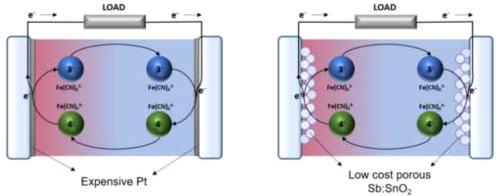当前位置:
X-MOL 学术
›
Electrochem. Commun.
›
论文详情
Our official English website, www.x-mol.net, welcomes your feedback! (Note: you will need to create a separate account there.)
Nanostructured and porous antimony-doped tin oxide as electrode material for the heat-to-electricity energy conversion in thermo-electrochemical cells
Electrochemistry Communications ( IF 4.7 ) Pub Date : 2024-02-25 , DOI: 10.1016/j.elecom.2024.107683 Sergio Castro-Ruiz , Jorge García-Cañadas
Electrochemistry Communications ( IF 4.7 ) Pub Date : 2024-02-25 , DOI: 10.1016/j.elecom.2024.107683 Sergio Castro-Ruiz , Jorge García-Cañadas

|
Thermo-electrochemical cells (or thermogalvanic cells or thermocells, TECs) have gained attention as devices able to convert low temperature heat into electricity. Within TECs, Pt is one of the most employed electrodes, since it exhibits a fast transfer of electrons with the redox couple in the electrolyte. However, its high price represents a serious drawback. Here, we analyze the use of nanostructured and porous antimony-doped tin oxide (Sb:SnO) as electrode material. Electrodes of different thickness (320, 550 and 1550 nm) were fabricated by spin coating to study the effect of the electrode area in contact with the electrolyte. F:SnO (FTO) glass was used as a substrate and the typical 0.4 M potassium ferro/ferricyanide aqueous solution served as electrolyte. An impedance spectroscopy analysis under operating conditions (10 K temperature difference) showed that the Sb:SnO electrodes exhibit the same excellent kinetics as Pt for all the different thickness. On the other hand, the power output density was thickness independent, since the temperature coefficients and the series and mass-transport resistances were similar, leading to no performance improvements when the electrode area in contact with the electrolyte was significantly increased. Finally, the Carnot-related efficiencies estimated for the Sb:SnO cells were in the same order of magnitude as for Pt electrodes. These results open the possibility to use Sb:SnO as a suitable electrode in TECs at low cost.
中文翻译:

纳米结构多孔锑掺杂氧化锡作为热电化学电池中热电能量转换的电极材料
热电化学电池(或热原电池或热电池,TEC)作为能够将低温热量转化为电能的装置而受到关注。在 TEC 中,Pt 是最常用的电极之一,因为它与电解质中的氧化还原电对表现出电子的快速转移。然而,其高价格是一个严重的缺点。在这里,我们分析了纳米结构和多孔锑掺杂氧化锡 (Sb:SnO) 作为电极材料的用途。通过旋涂法制备不同厚度(320、550和1550 nm)的电极,以研究电极与电解质接触面积的影响。 F:SnO (FTO) 玻璃用作基板,典型的 0.4 M 铁钾/铁氰化物水溶液用作电解质。操作条件(10 K 温差)下的阻抗谱分析表明,Sb:SnO 电极在所有不同厚度下均表现出与 Pt 相同的优异动力学特性。另一方面,功率输出密度与厚度无关,因为温度系数以及串联电阻和传质电阻相似,因此当与电解质接触的电极面积显着增加时,性能没有改善。最后,Sb:SnO 电池的卡诺相关效率估计与 Pt 电极处于同一数量级。这些结果为以低成本使用 Sb:SnO 作为 TEC 中的合适电极提供了可能性。
更新日期:2024-02-25
中文翻译:

纳米结构多孔锑掺杂氧化锡作为热电化学电池中热电能量转换的电极材料
热电化学电池(或热原电池或热电池,TEC)作为能够将低温热量转化为电能的装置而受到关注。在 TEC 中,Pt 是最常用的电极之一,因为它与电解质中的氧化还原电对表现出电子的快速转移。然而,其高价格是一个严重的缺点。在这里,我们分析了纳米结构和多孔锑掺杂氧化锡 (Sb:SnO) 作为电极材料的用途。通过旋涂法制备不同厚度(320、550和1550 nm)的电极,以研究电极与电解质接触面积的影响。 F:SnO (FTO) 玻璃用作基板,典型的 0.4 M 铁钾/铁氰化物水溶液用作电解质。操作条件(10 K 温差)下的阻抗谱分析表明,Sb:SnO 电极在所有不同厚度下均表现出与 Pt 相同的优异动力学特性。另一方面,功率输出密度与厚度无关,因为温度系数以及串联电阻和传质电阻相似,因此当与电解质接触的电极面积显着增加时,性能没有改善。最后,Sb:SnO 电池的卡诺相关效率估计与 Pt 电极处于同一数量级。这些结果为以低成本使用 Sb:SnO 作为 TEC 中的合适电极提供了可能性。











































 京公网安备 11010802027423号
京公网安备 11010802027423号